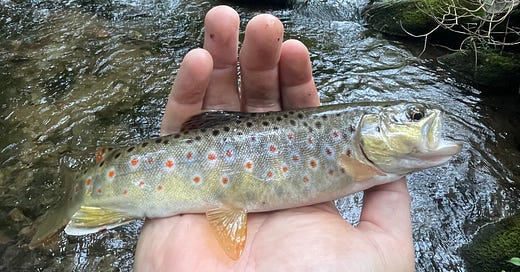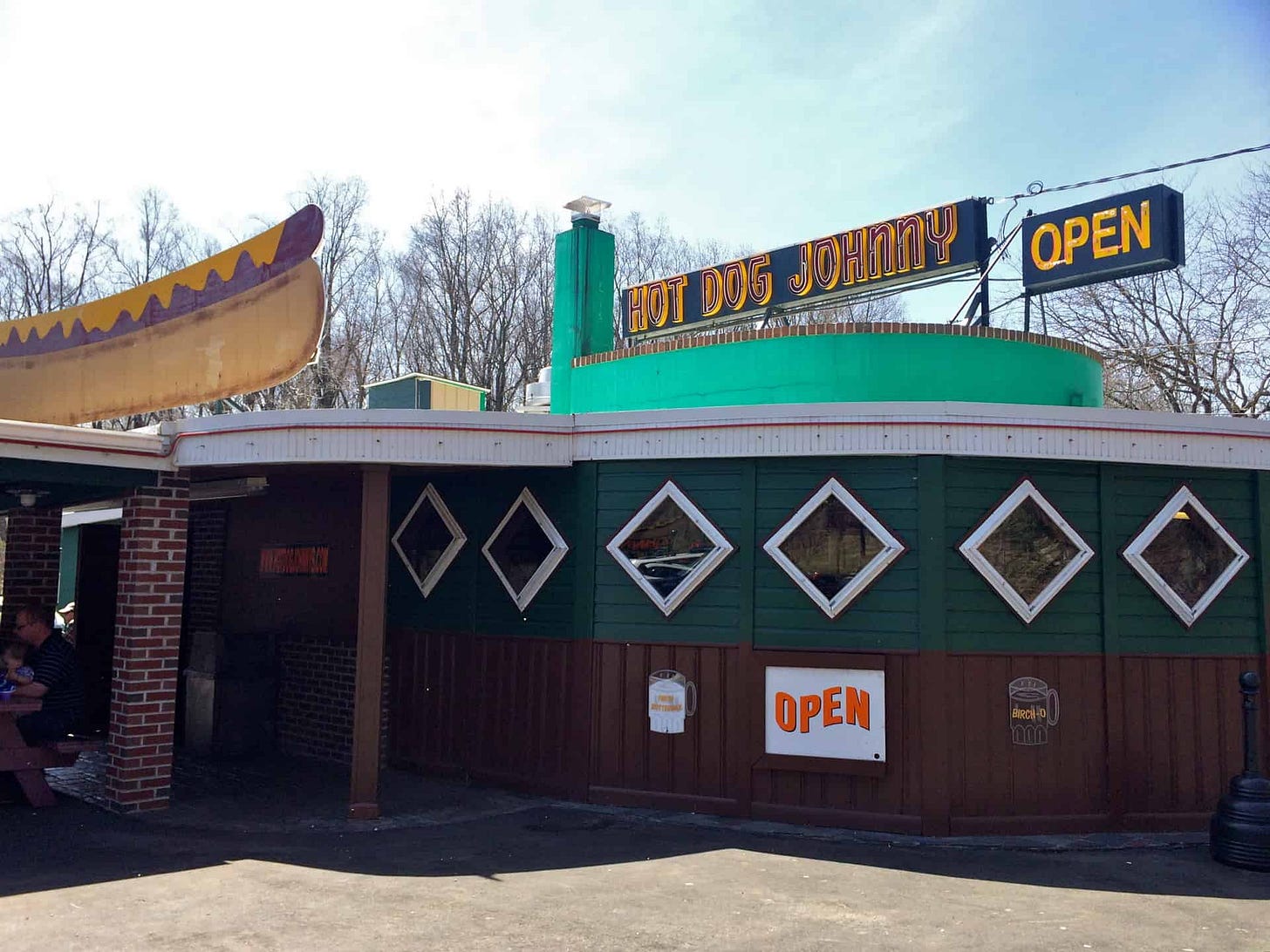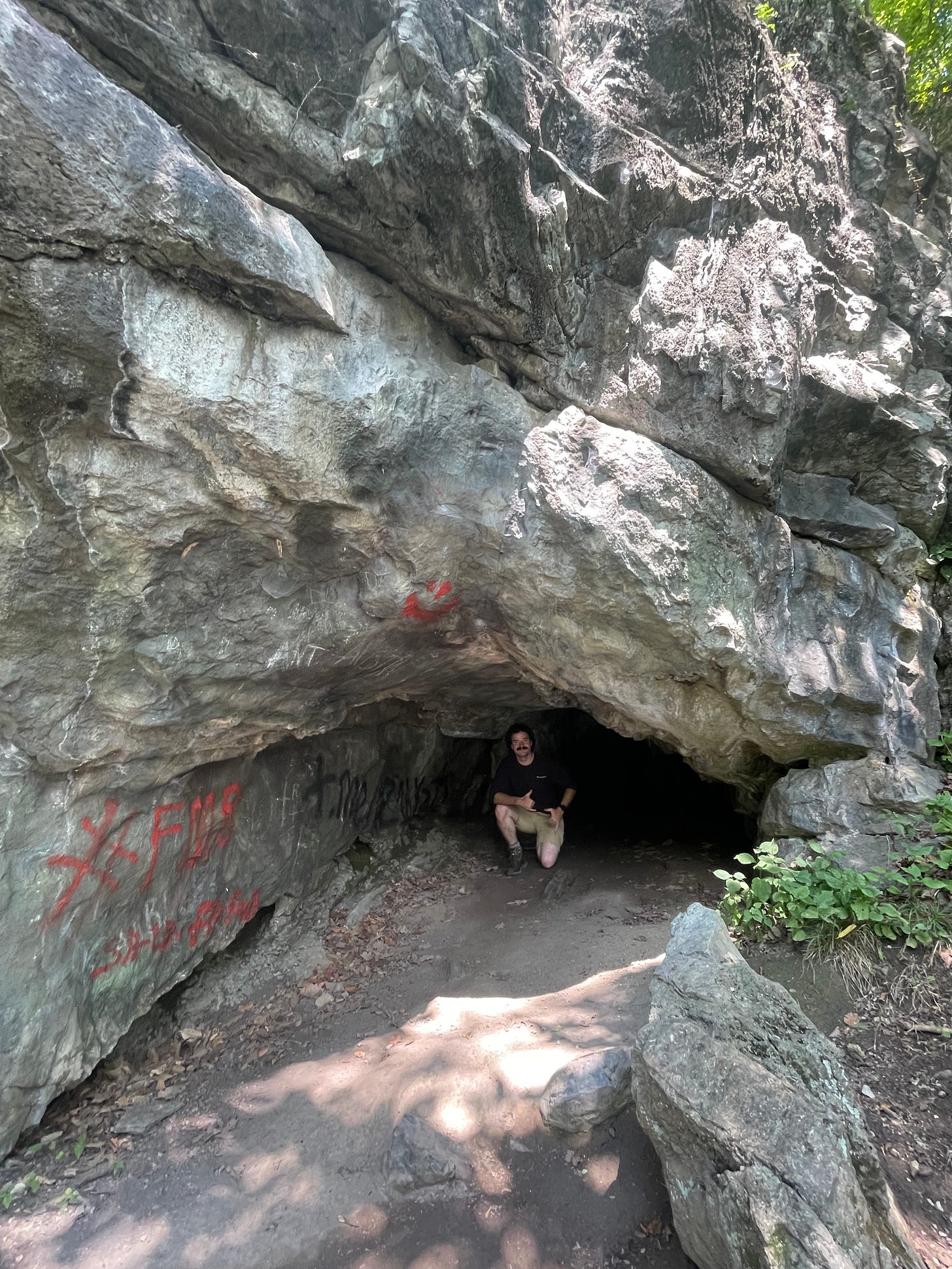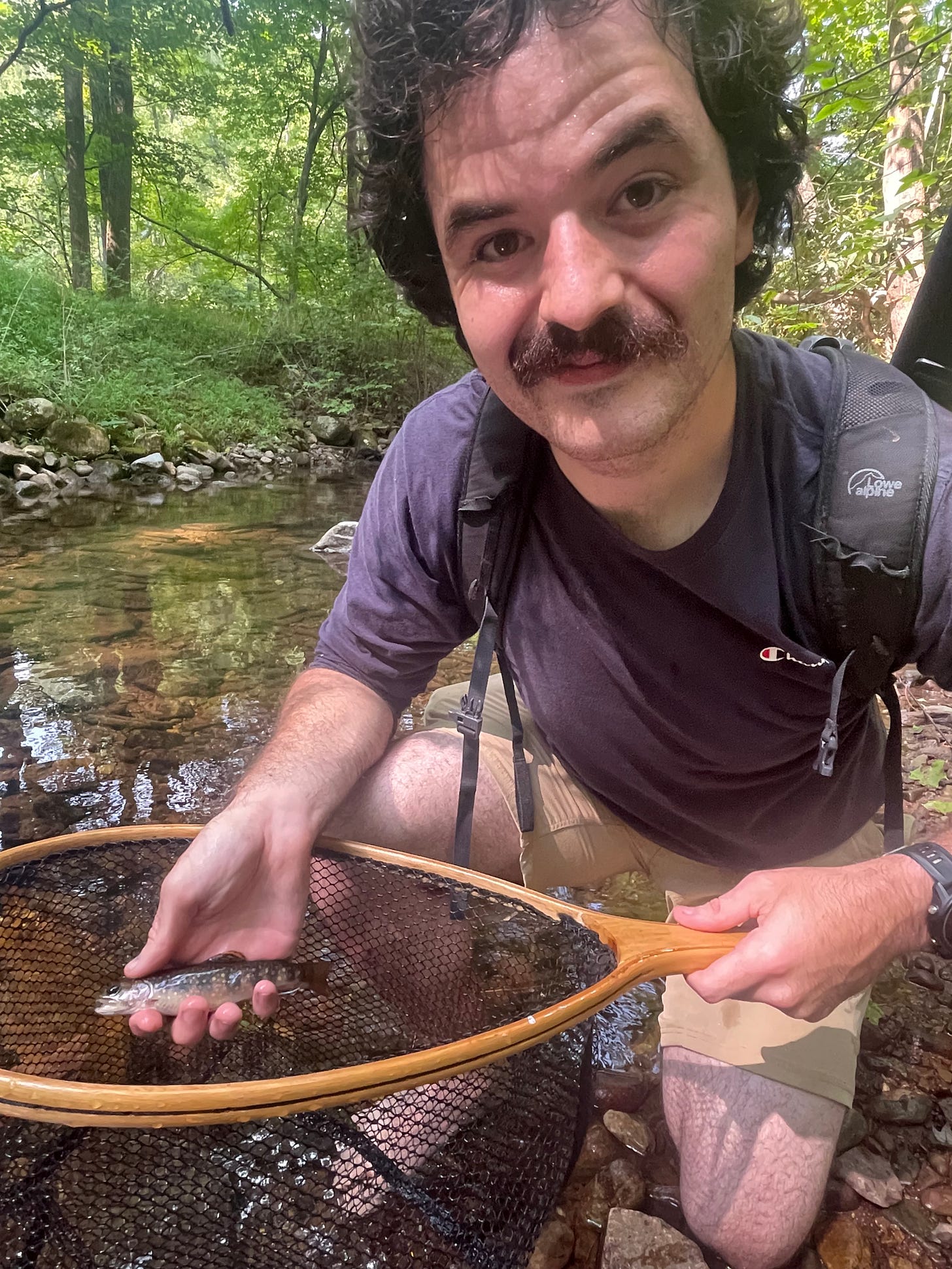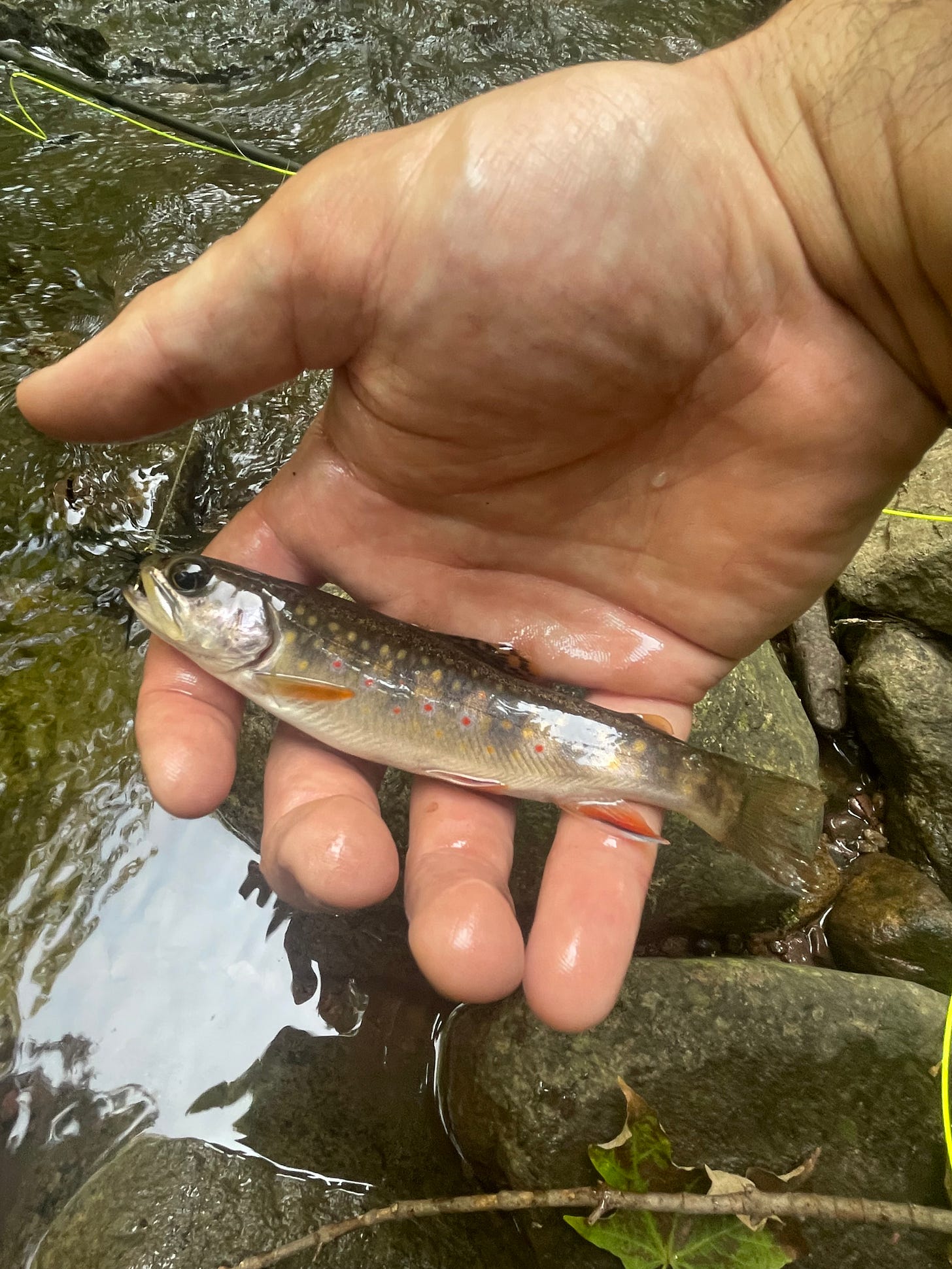Cheap Hotdogs, Ice Age Beaver Teeth, and Salvation on a Wild Trout Stream
Sometimes, little fish pack a big punch. Especially when you’re on a remote wild trout stream in the middle of backcountry nowhere, trying to reclaim the bit of your soul you left in the Amazon
Rhododendron roots trellis up the loamy banks of the creek. They look like the plaqued arteries of the mountain, siphoning nutrients from the stream and pumping them through the thick tangle of limbs and brambles that swaddle the current’s flow. I wade through the thick stuff, ankle deep in a clear run, and lay my fly rod on the bank. Then, I sit on a boulder and soak in a cool summer breeze. Upriver, wild trout rise.
My alarm clock shattered a dreamless sleep earlier that morning. It was 3:00 AM when I gathered my gear, swelled my cheeks with hot coffee, and set off to meet my brother. Chris lives halfway between my home in Cape May and the Delaware Water Gap, making his place a natural meeting ground for our journey north.
I arrived on his street by 4 o’clock and found him in the beam of my headlights. He was loading his truck with waders, fly boxes, and a tenkara rod. He turned and flashed a smile. Chris has the look of a rogue scholar. His long dark hair drapes around his head in feathery curls. A wiry black mustache cradles his upper lip and his pensive eyes look as if they lock years of thought and study behind them. When I greeted him at his truck bed, he told me he had packed an extra Clif Bar in case I get hungry while we fish.
Chris caught the angling bug while living in the Peru. His plane landed in Iquitos during the early summer of 2023. From the airport, he boarded a boat called a peque-peque- a small wooden boat, common in the Amazon basin. It’s slender like a canoe and outfitted with a long-tail mud motor, making it ideal for navigating the vegetation-choked streams of the rainforest. The peque-peque ferried Chris up the Amazon River and into its tributary, the Rio Napo. On the banks of the Rio Napo, Chris nestled in a small hut situated in the village of Sucasari. There, he lived alongside Sucasari’s indigenous people, the Maijuna.
His mission in Sucasari was to study the Maijuna’s methods of stingless bee husbandry. As a practicing entomologist, Chris was interested in understanding how the bees were cared for, what they foraged on, and what cultural importance the bees might hold for the Maijuna. Stingless bees lack a stinger but will chew on your skin when threatened. The pain of the bite is worth the taste of the sweet, golden honey they regurgitate. It has a loose consistency like the sweetwater of the Amazon itself, and tastes slightly more acidic than the kind of honey sold at American grocery stores. Between collecting data, licking up honey, and shadowing the town elders, Chris steeped in the life of the Maijuna, brewing in his mind a robust tea that blended the flavors of his own experience with the teachings of the rainforest.
One evening, Chris kayaked into the Rio Napo with two Maijuna guides named Victorino and Tony. They told Chris to thread some unknown hunk of jungle meat onto a hand-fashioned metal hook. The hook was latched to a single length of line, and the line wrapped around the end of a stick. After hours on the water, the whole crew drifted without a single bite. Chris noticed that when Victorino and Tony fished, they dipped the tip of their rod into the muddy water and thrashed it around vigorously, so he started thrashing too.
After a couple casts and shakes, Chris felt a tug that throttled his heart. He yanked back and sent the he rod into an arc. To its bend, he felt the weight of a fish. Out popped the silver flanks of a Sábalo, the Amazonian equivalent of a miniature tarpon. For dinner that night, the Maijuna served a heap of mashed yucca along with the Sábalo, which had been wrapped and smoked with some piranha in a banana leaf.
That was a year ago. Now, Chris wants to search the arteries of Kittatinny Mountain for the same high. The plan was simple. We’d arrive at the trailhead well before dawn, hike up from the Delaware River to one of New Jersey’s only wild trout streams, and fish our way to its headwaters. If we found no luck, we had a back-up stream running off the same ridge a half-hour up the road. In between, we’d check out one of the oldest archaeological sites in New Jersey and get some hotdogs. On the trail, it seemed like the plan would all come together.
It’s been an hour since we started fishing and I’ve just laid my fly rod on the bank. All the good looking water yielded no trout, but I found a few risers in small pockets. I lured a wild brown from beneath a bouldered ledge just moments ago. It took my fly without hesitation, and I’m wondering what else it’s been feeding on. I dip my hand in the current. The water laces between my fingers in cool braids as soft and smooth as silk. The water is spring fed, rolling as gently as a thousand liquid marbles over stone and pebble. I pluck one stone from the bottom. It’s the size of a melon. I hold it high above my head, angle it to the sun, flip it over, and twist it in my hand. I feel every crevice with my thumb and examine it with the scrutiny of a jeweler evaluating a diamond’s cut, until I find what I’m looking for: a congealed tube of sand the length of an eyelash. A caddis larva.
Upriver, Chris balances on a boulder carpeted with soggy green moss. All morning, he’s dealt with knotted lines, snagged tree limbs, slips, falls, missed hook sets, and even a close encounter with a trail porcupine. From the river rocks he tightropes, he continues to chip away, trying to rediscover the Sábalo, but the expression on his face tells me he’s battling frustration, trying his best but failing, to let his worries dissolve in the current.
He stoops low for the hundredth time and draws back on the tenkara’s furled line. He pulls his elbow high with the line pinched between his fingers. His thumb comes so close to his head that it nearly scrapes his earlobe. Then, he releases, shooting the line right below a rhododendron snag. The fly lands elegantly into the middle of a glossy run.
Of the 121 streams that actually harbor reproducing populations of brook trout in New Jersey, only a fraction are actually accessible, and of those streams, the fish are usually confined to just a small section. In the summer of 2019, I worked as a songbird biologist in the hill and valley communities of northern New Jersey, not far from where Chris and I fish today. When I wasn’t working, I tried to find those stream sections. It cost me leader and flies. Most days turned up no fish. If I was lucky, I’d knab a few creek chubs the size of breakfast sausages. Other days, I’d catch wild trout, but not the kind I was after. They were browns and rainbows, descendants of a stocked line. By the end of that summer, however, I had paid my debt in fly line. The brook trout I was awarded with wriggled in my hands like a psychedelic mirage. It looked as though someone had painted it in orange and yellow. A garland of concentric dots, red and green, speckled its side. Its fins were edged by a bold streak of white. It had a vermiculated back that looked like a colony of microcopic worms laying in squiggles. Native brook trout, I learned, carry a gravity that far surpasses their size.
The serenity wild trout has that effect. The landscape holds a magnifying glass to even the tiniest of fish, inflating their impact, and when you land one in your net, you feel its weight, large and looming. You feel the seriousness of the situation. The creek murmurs as a pileated woodpecker cries from a distant hemlock, but you’re sucked in the current, drowning in the untamed beauty of a wild brook trout.
Today, I’m aiming to share that experience with Chris. Catching wild brook trout in these streams is the closest I’ve come to relating to his story of the Sábalo. On his next cast, Chris snags a rhododendron and, in a combative attempt to free his fly, whips his tenkara. His line pulls taught as I watch the carbon fiber of his rod crack into a stress fracture. The top quarter of his rod now lays limp like a windless flag. We decide to cut our losses. We pack our gear and hike back to the trailhead.
—
Hot Dog Johnny’s, on US-46 in Belvidere, splits the word hotdog into two; they sell the food, but in the August heat, Chris and I dig into their grease-stained paper bags feeling as hot as hounds.
From the picnic tables that lay under a gazebo on the restaurant's side, customers get a clear view of the Pequest River. A great-blue heron wades in its current as Chris and I indulge. Somewhere along our fishing trip, our appetites turned ravenous. The receipts laid on the splintered boards of our table sum up to just a few bucks each. The hotdogs and the fries we split taste as inexpensive, but Hot Dog Johnny’s caters to an endless line of customers between 9:00 AM to 9:00 PM. Little wild trout in an untamed stream carry disproportionate weight, and apparently, so does a hotdog stand in the middle of North Jersey Nowhere.
We reflect on our morning as we eat. I caught two wild browns. The first one was so colorful it reminded me of a brook trout. The second one darted from beneath a boulder into an eddy where my fly landed. I saw it coming for the fly before I set the hook. Chris gnaws his hotdog down to a nub when he starts reviewing his lack of fish and the frustrations that came with it. He speaks in an apologetic tone. His curly hair sticks to his forehead and shines with a glossy veneer of sweat. His mustache turns into a paper shredder as he finishes the nub. He wasn’t apologetic to me, he says, but to the creek and to himself.
He explained that ever since Peru, fly fishing has always been about the pursuit of nature, with frustration and failure an integral part of the journey. He wasn’t mad about the lack of fish. He wasn’t even so mad about the broken rod. He was frustrated with the thought of frustrations, and how they could taint the wild ground beneath him. If he could overcome the frustrations in fly fishing, he added, maybe he could overcome frustrations in the real world, too.
The neon sign hanging above Hot Dog Johnny’s turns into a tiny script reflected in the rearview mirror as we drive to plan B. The summer I lived up here surveying birds, I had read an archaeological report detailing a cave site that contained some of the oldest known human artifacts in New Jersey. Among ancient pottery and stone tool implements, the cave contained a giant beaver molar. I wanted to see where they found it.
The giant beaver, Castoroides, lived in America during the Pleistocene epoch from 1.4 billion to 10,000 years ago. Researchers believe Castoroides lived alongside the beavers we’re all familiar with. Our beavers chew trees and build dams. Nitrogen-isotope analyses suggest that the giant beaver preferred submerged aquatic vegetation. Non-overlapping dietary preferences allowed the two beavers to coexist peacefully.
Perhaps they both lived in the lake beneath the cave. Scientists radiocarbon dated collagen extracted from the giant beaver molar and found that it dated back to at least 11,000 years ago. At that time, the landscape around the cave probably looked a lot like it does today, albeit colder.
The molar’s position among human artifacts suggest some sort of human use. The giant beaver could have died in the wetland that sits beneath the cave. It could have been scavenged by ancient humans and its remains roasted over a fire. Native Americans could have hunted it. They could have slow roasted its mandibles and picked tender meat from the jowls. Their stomachs could have growled and their hands could have been greasy. Smoke could have plumed from the cave as stars emerged in the sky.
Chris and I climb a faint hiking trail up the slope of a mountain and crouch-walk into the depths of the fifteen-foot cave. The one side is stained by the soot of a thousand fires. Layered on top of it are the spray painted signatures of vandalizers. When archaeologists excavated the cave in the early 1900’s, they made note that the site had already been looted, and most of its most ancient artifacts were probably already locked up in somebody’s display case. I put my palm to the ground and feel the fine grains of cave dust. They’re cold and have the consistency of flour. Chris and I sit in a moment of silence as I wonder what else lays beneath the mountain.
We drive from the cave a half-hour through a winding mountain road to Plan B brook. Plan B brook runs through a flat valley rich with hickories and brambles. The slopes beyond the creek lead to lush groves of mountain laurel and if you were to shave it all back, you’d likely find the last vestiges of New Jersey’s ruffed grouse mixed in with a diverse faunal array including timber rattlesnakes, bobcats, whitetail deer, black bears, newts, and dung beetles.
Boulders shift beneath my boots as I hopscotch upriver to an enticing stretch of runs and riffles. I pick at each covert with delicate casts. Downriver, Chris works with his telescopic tenkara. He retracted the section of rod with the stress fracture to the point where it was contained within the lower section. The rod, now shorter, can withstand the pressure of casts without splitting in two.
—
Frothing water muffles the ground between Chris and I. We’re working sections so distant I can’t see him when I pull a pinky-lengthed rainbow trout from a pocket of glittered water. The fingerling has a snub nose and a chain of eight pink spots that run the length of its lateral line. In my palm, I can feel its frailty, and I gently lower it back into the water. Its body rattles into a languid tail shake that thrusts it into the current.
Upriver, a riffle flattens into a smooth pool reflecting a glimmer of dappled light. The rhododendron leaves above it rustle in the slightest breeze. It drops loose leaves and insects into the current. The leaves ride high like buffalo-skin boats and the hungry mouths of feeding trout create periodic funnels that break the water’s smooth surface. They’re vacuuming the bugs. I study its flow, count the rising trout, and hike back to meet Chris.
He’s tangled in a rhododendron branch when I arrive, his wiry mustache bent into two downward spirals that frame his mouth.
“I’ve got good water upriver,” I tell him, “When you get untangled, meet me up there.”
Chris nods his head without a word, and a few minutes later, he stands beside me at the tail of the pool.
Rings and ripples dot the run like rhythmic rainfall. The trout feed with a consistency that reminds me of fish rising to pellets in a fish tank. It’s probably caddis, but we’re working with a limited fly box containing terrestrials and some flies I sewed together almost ten years ago. We look at the selection. One mangled fly imitates nothing, we decide, except for a jacked up moth. It has white-fiber wings and a dun-colored body. It has no texture, no life, besides the frayed fibers. But it looks fishy. And Chris is eager to change out his floating ant after having no luck all day. I watch trout break the topwater as Chris ties on the new fly.
We talk about the approach and staying low. We dissect the scene like Army generals evaluating a battlefield. We consider everything that could go wrong. Low hanging branches look eager to snag a line. The current is hemmed by thick bushes that plume over the bank, making side casts impossible. It’s typical small stream fishing. A stealthy approach to the boulder at the tail of the run, laying on the left bank at the edge of the bushes, could work. From there, if Chris whipped his rod to the right, he’d hit the opposite bank, but he could aim upcurrent, and peel back line for a low bow-and-arrow cast. With any luck, he’ll avoid the rhododendrons overhead. Fishing in a bark covered tunnel is tough, but with a little finesse, he could land his fly right above a feeding trout.
Chris slips out of his boots and sneaks upriver barefoot, crouched low and taking methodical steps toward the boulder as if he were stalking a wounded animal. The omnipresent sound of whitewater muffles the shifting rocks beneath his feet. I cross the creek to catch a better view of the water in front of him. Another trout rises as Chris draws his leader. He shoots his fly and it lands with a thud. The current carries it back to him. Nothing. He recasts. I see more trout break at the head of the pool. Nothing. He casts again. Nothing. No takes. He takes a step forward as I gauge his facial expression, half expecting to see the frustration boil up within him, but I can’t get a read. His fly sails again, narrowly missing the rhododendron branch, and ripples emanate from where the fly lands. I see the frayed wings floating high. I hear the murmur of the creek and I feel Chris’ concentration. The fly drifts with the bubbles. Then, it’s inhaled.
“Pull back!”
Chris lifts his rod high as if he’s trying to brush the clouds. His fly line sweeps in violent arcs through the pool.
“Keep the tension!”
Chris backs up and steps off his boulder as the trout makes a dart downriver. I scramble for my net.
“Keep the tension! Bring it over here.”
Chris finds his footing on the wet rocks and turns his rod toward the opposite bank in an attempt to guide it to my net. The trout darts again toward his ankles, then U-turns back toward the bank and upstream of my net. I dip the net low and drag it against the current, under the belly of the trout, heaving it up in a gentle swoop. The weight of the trout sags the mesh. Water dribbles as I lift it out of the creek. I look inside. A wild brook trout.
Chris’ cheeks rise in a subtle smile and his pensive eyes unlock. For a moment, they look like they’re dropping down a guard and allowing the world and the creek and the trout and everything that matters sponge into his psyche. He cups his palms and scoops the trout out of the net as if it were a sacrament. He holds it to his chest and gazes into his hands. The moment lingers and the long exposure imprints an image into his mind.
“Every brook trout is different, you said. Like a fingerprint. I don’t want to forget this one.”
I take a photo of him with the trout, a backup copy for a memory he’ll never forget. Then, he lowers the tiny fish back in the water, and we watch it wriggle into a fast seam before it darts off for good. He picks up his rod and strolls across the creek, back to his boulder perch, with the grace and silence of a wading egret.
I head off on a solo hike and return to the creek as the sun dips low in the sky. Chris doesn’t know I’m there when I arrive, so I take a few moments to watch him fish. He’s threading his fly line between the branches. He’s crouched low and fishing with a confidence he didn’t wake up with. The current rolls and he cements a gentle smile. Somehow, he seems in harmony with the water and the mountain. He hasn’t snagged once since he caught the fish.

